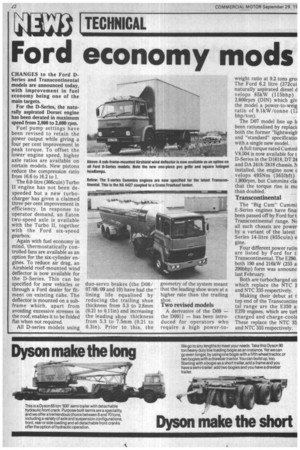Ford economy mods
Page 24

If you've noticed an error in this article please click here to report it so we can fix it.
CHANGES to the Ford DSeries and Transcontinental models are announced today, with improvement in fuel economy being one of the main targets.
For the D-Series, the naturally aspirated Dorset engine has been derated in maximum speed from 2,800 to 2,600 rpm.
Fuel pump settings have been revised to retain the power output while giving a four per cent improvement in peak torque. To offset the lower engine speed, higher axle ratios are available on certain models. New pistons reduce the compression ratio from 16.6 to 16.2 to 1.
The 6.0-litre (366cuin) Turbo 11 engine has not been despeeded but a new turbocharger has given a claimed three per cent improvement in efficiency. In response to operator demand, an Eaton two-speed axle is available with the Turbo Il, together with the Ford six-speed gearbox.
Again with fuel economy in mind, thermostatically controlled fans are available as an option for the six-cylinder engines. To reduce air drag, an Airshield roof-mounted wind deflector is now available for the D-Series. This can be specified for new vehicles or through a Ford dealer for fitment on existing cabs. The deflector is mounted on a subframe which, apart from avoiding excessive stresses in the roof, enables it to be folded flat when not required.
All D-series models using duo-servo brakes (the D06/• 07/08/09 and 10) have had the ' lining life equalised by reducing the trailing shoe thickness from 5.3 to 2.8mm (0.21 to 0.11in) and increasing the leading shoe thickness from 5.3 to 7.5mm (0.21 to 0.3in). Prior to this, the geometry of the system meant that the leading shoe wore at a higher rate than the trailing shoe.
Two revised models
A derivative of the D09 — the D0911 — has been introduced for operators who require a high power-to weight ratio at 9.2 tons gro: The Ford 6.2 litre (372cui naturally aspirated diesel d velops 85kW (115bhp) 2,600rpm (DIN) which giv the model a power-to-weig ratio of 9.1kW/tonne (12 bhp/ton).
The D07 model line up h been rationalised by replaci] both the former "lightweigh and "standard" specificatio with a single new model.
A full torque rated Cummi V8.504 is now available for t D-Series in the D1618, DT 24 and DA 2418/2818 chassis. N installed, the engine now c velops 495Nm (3651bft) 1,900rpm, but Cummins cla: that the torque rise is mc than doubled.
Transcontinental
The "Big Cam" Cummi E-Series engines have final been passed off by Ford for t Transcontinental range. Nc all such chassis are power by a variant of the latest Series 14-litre (855cuin) e gine.
Four different power ratin are listed by Ford for tl Transcontinental. The £290. both 190 and 216kW (255 a 290bhp) form was announc last February.
Both are turbocharged un which replace the NTC 2 and NTC 335 respectively.
Making their debut at t top end of the Transcontine tal range are the E350 a] E370 engines, which are turl charged and charge-cook These replace the NTC 35 and NTC 355 respectively.
























































































































